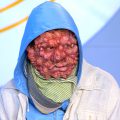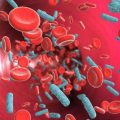Diphtheria in adults is one of the heaviest in the diagnosis and treatment of infectious diseases. At the same ailment is not only developing inflammation in organs, an infection, but there is a strong intoxication of the whole organism.
Through regular routine immunization diphtheria in adults it does not occur very often, but the disease is a threat to life, therefore it is necessary to know the symptoms and effects, and be able to treat and prevent disease.
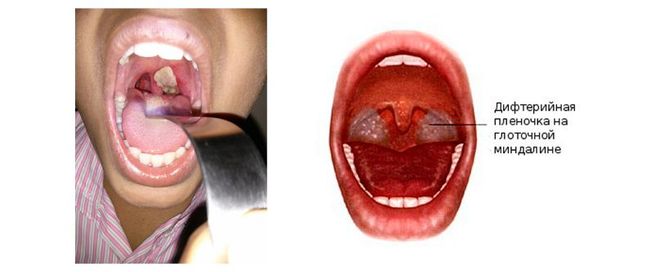
What is diphtheria
Diphtheria is a disease of an infectious nature, caused by the bacterium Corynebacterium diphtheriae. The illness always appears in acute form and is characterized by a rapid increase of inflammation in the focus of the introduction of bacteria and toxic heavy defeat of all organs and systems.
At the place of implementation and localization of bacterial infections diphtheria can be subdivided into several forms:
- diphtheria nose;
- Diphtheria upper airways;
- diphtheria eye;
- Krupoznaya diphtheria;
- rare diphtheria (genital organs and wounds).
The disease is also classified according to severity:
- Netoksicheskaya - a form of the disease is more common in vaccinated people. In this case, the disease is not complicated by severe symptoms of intoxication.
- toxic - there is a strong intoxication, accompanied by a swelling of the neck.
- sub-toxic - moderately expressed intoxication.
- Gemorrogicheskaya - is characterized by severe symptoms of intoxication and bleeding from the site of the lesion of varying intensity. It can be fatal to the already 4-6 day.
- hypertoxic - the rapid increase in symptoms, which leads to rapid death (in the next two days).
The incubation period is from two to ten days - during which time it is important to diagnose and begin to treat disease, since later 5-6 days after the development of the disease even vaccinated against diphtheria, adults will not be able to help avoid complications.
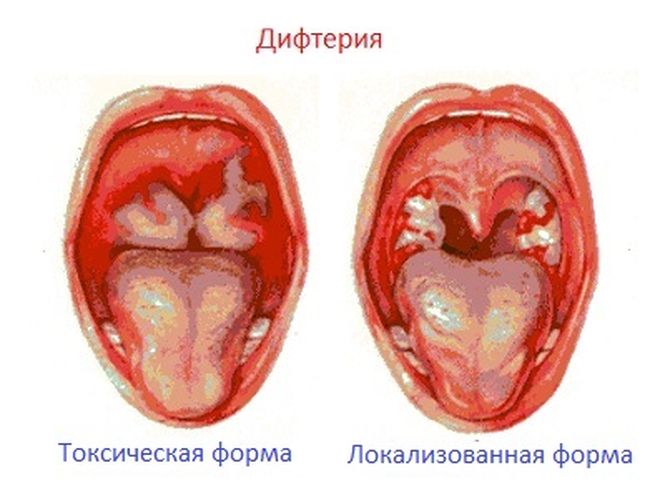
How does the disease
The source of transmission of the causative agent of diphtheria becomes very sick person or bacillicarriers. In most cases, diphtheria bacillus is transmitted by airborne droplets, but also the pathogen can be transmitted through infected objects (door handles, towels, dishes) or food (frequently - meat or milk).
For, The infection is transmitted to the skin, eyes or genitals enough just one touch of an infected person.
Important! Diphtheria - contagious disease, often transmitted by airborne droplets.
Favorable factors for the development and emergence of diphtheria could be transferred flu, ORVI, chronic upper respiratory illness.
Once the bacterium enters the body, at the point of penetration formed the focus of inflammation. inflamed tissue, there is swelling, appear fibrinous film, which tightly fits the affected mucous membranes or wounds.
Diphtheria begins to actively multiply and release toxins, which by lymph spread throughout the body, affecting the nervous system, kidneys, a heart, liver and other vital organs.
After undergoing diphtheria in man is formed in the body temporary immunity, thanks to which it is impossible to catch infection again. Vaccination against diphtheria for adults does not protect against infection, but it allows you to move the disease milder.
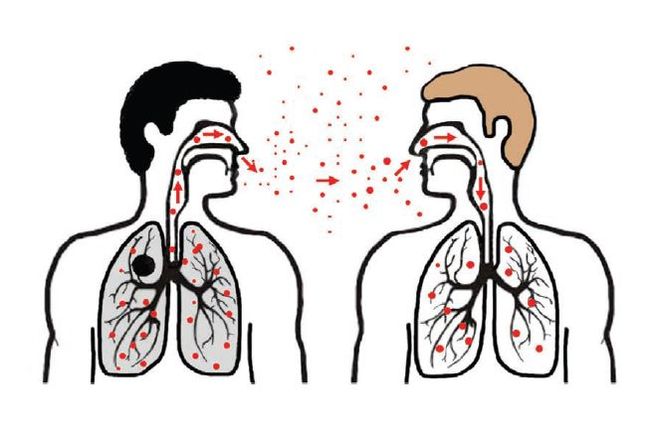
symptomatology
The first signs of diphtheria in adults - a slight rise in temperature (which persists for quite a long time), specific discharge from the inflamed places, their swelling and soreness (It looks like diphtheria oropharynx seen in the photo).
note! Symptoms of diphtheria is often confused with angina, but there are some features of the disease, you should know.
Symptoms in adults depend on the lesion, but during reproduction causes diphtheria toxin intoxication symptoms typical, common to all forms of the disease:
- Pallor;
- general malaise;
- Tachycardia;
- Fever;
- Extreme weakness;
- Drowsiness;
- Headaches;
- swollen lymph nodes.
You'll find most of diphtheria oropharynx (90% all cases), but there are other forms of the disease, symptoms that also need to know.
diphtheria rotoglotki
The disease begins abruptly and occurs in acute form:
- Heat (38-40 degrees);
- Moderate edema tonsils, palate and soft handles;
- general malaise;
- Difficulty in swallowing;
- Pallor;
- Scratchy throat and hoarseness;
- Lack of appetite;
- Pain and redness in the throat.
In the first two days of illness fibrinous raids on resemble jelly, then (after 2-3 day) become tight, smooth, grayish color on. Painful attacks are difficult to remove, when removed, the mucous begins to bleed, and the next day increases to a new place of the removed film.
diphtheria nose
At a given species of organism intoxication disease sufficiently moderately expressed. The patient is observed difficulty breathing, appear purulent nasal discharge or sukrovichnye.
Nasal mucosa swelling, her visible redness, sores, erosion, fibrinoznыe naletы (they can be easily removed, like shreds). Around the nose of the skin may appear brown and irritation.
This form usually occurs on the background of diphtheria eyes or respiratory tract.
Krupoznaya diphtheria
Lobar diphtheria divided into common (When the larynx is affected, trachea, bronchi) and localized diphtheria (It affects the pharynx or larynx).
Due to the nature of construction of the larynx in adults lobar diphtheria develops longer, than children. The only sign, indicating the occurrence of diphtheria, often is the lack of air and hoarseness.
When diphtheria common symptoms following:
- Intense barking cough;
- Arrhythmia;
- Pallor;
- Labored breathing;
- hoarseness.
As the disease progresses the patient begins to decrease blood pressure, the pulse becomes weak and can come confusion and loss.
diphtheria eye
This form of the disease can occur in three variants:
- catarrhal form. symptoms: inflammation of the conjunctiva, slight discharge from the eye ichor, Body temperature rises slightly (or does not rise), There are no signs of intoxication.
- Plenchataya form. symptoms: the formation of a fibrin film in the lesion, severe swelling of the conjunctiva, serous-purulent discharge from the eyes, low-grade fever, moderately expressed intoxication.
- toxic form. Characterized by a rapid start of a rapid increase in the symptoms of intoxication. In this highly swollen eyelids and swelling may spread to adjacent tissues, inflammation of the conjunctiva can spread to other parts of the eye.
Diphtheria is rare localization
This form of diphtheria is rare and often enough developing against diphtheria throat or nose. Lesion area are the wound surface or genitals.
When diphtheria genitals inflammatory process observed in the vaginal area (among women) and on the prepuce (men). Sometimes inflammation can involve the perineum and anus. In the lesions observed swelling, begins to stand ichor, when trying to urinate pain is felt.
When diphtheria cutaneous sites pathogen introduced into the wound site, cracks, oprelosti, scrapes. The skin appears dirty-gray color film, out of which pus. Local symptoms manifest themselves very long period, but signs of intoxication are moderate.
Treatment
Diagnose diphtheria alone is very difficult - the clinical picture of the disease has many symptoms, similar to other diseases. Establish an accurate diagnosis can only be a doctor, and then only in a hospital environment, tk. to confirm the diagnosis will have to make a number of studies:
- Hand over blood and urine tests;
- Make Bacteriological sowings;
- Undergo serology.

note! If you have symptoms of acute diphtheria, accompanied by purulent discharge, swelling of tissues, disturbances of consciousness, heart operation, loss of consciousness, you should immediately call the "emergency".
Treatment diphtheria occurs strictly under stationary conditions in an infectious ward. Length of hospital stay depends on the degree of disease severity.
The main method of treatment of diphtheria - the introduction of an adult patient diphtheria serum, which neutralizes toxins, allocated exciter. The introduction of serum do immediately - as soon as a patient arrives (no later than the fourth day of the disease). In the presence of a patient allergic to serum components are further assigned to receive antihistamines.
measures detoxification:
- fluid management;
- hemosorption;
- Plazmoforez.
At sub-toxic and toxic form of diphtheria carried antibiotic: drugs erythromycin, penicillin, tsefalosporinы, tetratsiklinы.
In severe cases, surgical treatment:
- When croupous diphtheria - removing fibrotic carried films special surgical instruments (under general anesthesia).
- With the rapid build-up of respiratory failure - tracheostomy or tracheal intubation.
Patient discharged after, It confirmed his recovery double negative bacteriological analysis. After discharge, the patient is subjected to compulsory medical check-ups for three months.
The dangerous diphtheria
Infektsionnыy toxin, causes diphtheria, It leads to severe complications, which constitute a risk of disease. When a localized form of diphtheria serious consequences occur only 10-15% all cases, and in toxic (or subtoxic) form likelihood of complications increases to one hundred percent.
possible complications:
- Myocarditis;
- suprarenalopathy;
- Cardiovascular and respiratory failure;
- Toxic shock;
- Otitis;
- Pneumonia;
- DIC;
- toxic nephrosis;
- peritonsillar abscess.
Complications develop, depending on the severity of diphtheria and its kind. So, toxic myocarditis usually appears to 2-3 week of disease, and optic neuritis may develop months after recovery.
Prevention - vaccination against diphtheria
The most effective and the main measure of prevention is vaccination against diphtheria, whereby the organism is introduced a diphtheria toxoid (devoid of toxic properties of diphtheria toxin).

How often are vaccinated against diphtheria in adults?
If vaccinations against diphtheria were carried out in due time, the adult needs to do every vaccination 10 years old, with age - 14-16 years old.
If a person does not remember, when he made vaccination against diphtheria, and vaccination card has no data on vaccination, the schedule changes; vaccination takes place in two stages with an interval 30-45 days. after 6-9 months is the first revaccination, and the second - after 5 years old.
What preparation is used to inoculate?
The drug is used for adults against diphtheria and tetanus Td toxoid, which comprises tetanus and diphtheria toxoid in an amount of five units and adjuvants.
Where are vaccinated against diphtheria?
Can be vaccinated in the chuck area or in the outer thigh intramuscular.
Are there any side effects from the vaccinations?
Typically, the vaccine well tolerated, only in rare cases, there are minor side effects.
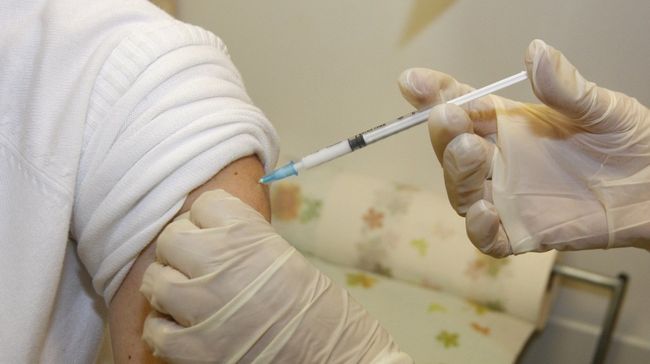
Grafting may feel slight discomfort during the first day after vaccination. It may also significantly increase the temperature. A shot may be a bit itchy, It is marked locally administering slight redness and swelling.
Modern vaccines are well cleaned, They do not contain harmful toxins, so often do not cause side effects and well tolerated.
Do I need to be vaccinated?
Reviews of physicians and patients show, that non-vaccinated patients Diphtheria occurs with complications, in severe and often causes death cases.
Graft Patients often are simply carriers of diphtheria, they fixed the localized form of the disease, mild course of the disease with a favorable prognosis.
Diphtheria - a very dangerous infection, which often ends lethal complications and acquisition mass. It is better to prevent the disease in advance and do regular vaccination clinic.



